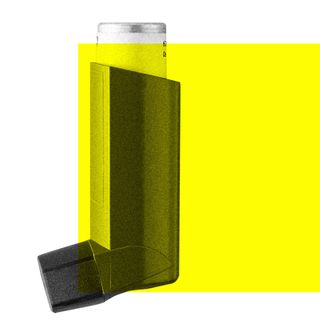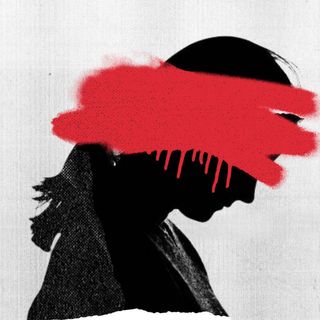
What It’s Like To Live With: Sudden Paralysis of the Face
“I kept thinking about whether I’m ever going to be any degree of social after this — I just didn’t know how I’ll ever face people.”

What It’s Like to Live With explores the stories of people who see and experience every day a little differently.
I had a headache around three days before the paralysis happened. My ear had also been hurting for a couple of days. At the time, I was in the 29th week of my pregnancy, which was already classified as “high risk” since I was pregnant with identical twins.
The thing is, during pregnancy, anything that happens to you is automatically attributed to the pregnancy. So, when I was experiencing these pre-paralysis symptoms, I just thought, “Okay, maybe, my immunity is just low, and I have, like, an infection or something.” So, I was just taking my antibiotics.
Then on the day the paralysis happened — it was very, very sudden. I had no time to get used to it. I was talking to a relative on the phone after I woke up that morning when, out of the blue, I felt as if one side of my face was just not moving. I remember rushing to the mirror. It looked exactly like it felt — the left side of my face was not moving. I was terrified. I mean, the thing you associate the most with paralysis in one side of your body is a stroke. So I thought my brain is hemorrhaging or something.
But it wasn’t a very “obvious” paralysis — like, visibly, there was only a very slight “distortion,” and on that day, I could still speak without my speech being affected. I could feel it though — like, when I was smiling, I could sense that only one side of my face was curling up into a smile.
I rushed to my husband, told him what was up, and insisted that we rush to the emergency room. But since what was happening wasn’t exactly apparent to him, he suggested that I just rest for a while since he thought I have just slept on one side, and so my face was feeling stiff. He assured me it’ll be fine soon enough. But I tend to be very paranoid about my health, and I just knew it was paralysis. So, I stood my ground and convinced him to accompany me to the doctor immediately. I’m really glad we did that because I learned later that Bell’s palsy [an unexplained onset of partial facial paralysis] is time-critical — you have to start with steroid-based medication within 72 hours of onset, and the faster you start, the greater the chances of full recovery are. My instincts had guided me well.
You get diagnosed with Bell’s palsy by elimination when doctors rule out the possibility of it being a stroke, or a tumor, or an infection, and so on. When I found out the most probable diagnosis is that of Bell’s palsy, mentally, I was all over the place. I hadn’t heard of the condition before — it was completely new to me. So, I didn’t know what to make of the diagnosis or how to feel about it. No one knows what causes Bell’s palsy either; even the doctors couldn’t say. I was freaking out.
Related on The Swaddle:
What It’s Like to Live With: Muscular Dystrophy
What they also didn’t tell me then was that the condition could just as easily be temporary — I guess, they didn’t want to give me that hope. Eventually, I just Googled it; I know I probably shouldn’t have, but I just did. I found out that 90% of people recover, and my immediate reaction was: “Wait, what about the other 10%?” I was constantly worried about being among that 10%.
Since this happened during pregnancy, we rushed to our maternity clinic itself. They are, for obvious reasons, more concerned about the pregnancy since that’s what they specialize in. So, they immediately began testing whether my babies’ hearts were beating normally. Turns out, they were fine, and I could go back home too.
I remember people assuring me — saying it’s a good thing that, at least, nothing happened to the babies. While I’m grateful for that, I was wondering if that is supposed to just make me feel completely okay. I don’t think anyone really got what I was going through — my face that I’ve lived with for 29 years was suddenly paralyzed, and I was sitting there scared that it was going to be like that forever. I didn’t want to tell everyone what I was thinking though because I was worried they’d think my concerns were superficial as a pregnant woman. I was happy my babies were fine, but I was also feeling terrible thinking about my face — I mean, they don’t have to be mutually exclusive, right?
I was very depressed for the next three to four days. I was just sluggish all the time and didn’t want to talk to anyone — I just wanted to stay in my room. I didn’t feel like getting up from the bed, or eating and drinking anything. I was, basically, exhibiting all the classic signs of temporary mental distress. In general, of course, this is bad, but it was worse in my case since I was in the third trimester of my pregnancy. In time though, I just had to make myself somehow “snap out of it.”
Bell’s palsy progressively worsens over the course of, at least, a few days following the onset. By the third day, anyone could tell one side of my face was paralyzed — right from lifting my eyebrows to smiling to moving any of my facial muscles really. I kept Googling all kinds of things and reading accounts of people who never fully recovered. The majority of articles I read online were negative.
I wanted to reach out to somebody within India, who has dealt with what I was going through, so I could learn more about their experience. I wanted to know what other options I had besides allopathic treatment — for instance, could I try acupuncture or get physiotherapy? Unfortunately, I couldn’t find anyone to answer all my questions. I just couldn’t find any support groups on social media either, and I was trying desperately. I just wanted to talk to someone I could relate with. But most people I talked to hadn’t even heard about this.
Related on The Swaddle:
What It’s Like To Live With: Cerebral Palsy
On some level, it was like I was mentally preparing for my face to be like that forever while also worrying if I’m being shallow — because, physically, there was nothing wrong; neither was my life in danger, nor were my babies’ lives. But I couldn’t stop worrying about my face. It’s not just about how you look, right? Everything — from your expressions to the way you talk, you smile — adds to your persona. I kept thinking about whether I’m ever going to be any degree of social after this — I just didn’t know how I’ll ever face people.
But, at this point, my husband helped me a lot — he was my solid pillar of support. I used to cry to him a lot, and he never told me I was definitely going to get better. Instead, he said that even if we were to assume the worst — that is, if my face stays like this forever — it’s going to be fine and I have to learn to live with it, that’s all. Basically, he was giving me a lot of pep talks those days. Eventually, I thought, “Okay, let me hope for the best, and prepare for the worst.”
My mother-in-law, who was also staying with us at the time, continued to behave with me like everything was normal — as if I was just dealing with an ear infection, which caused a slight swelling on one side of my face. This was actually very helpful because I wasn’t really in a state to actively talk about what was going on all the time. So, it was great that she was talking to me and treating me like she normally would.
At my worst, I could still speak coherently, but there was a loss of clarity in my speech for some words. I was having some trouble swallowing water though — it would drip. So, I had to take very small sips of any liquid and chew my food only from one side of the mouth. But, thankfully, I began recovering in two weeks.
I’ve read that Bell’s palsy rarely comes back post-recovery. But the whole of last week, I had this weird headache and the same side of my face that was affected was twitching again. I was worried, of course, since they were the same symptoms I’d experienced before the onset. Thankfully, nothing has happened yet. And, honestly, I know that even if it does, this time, I’ll be able to deal with it better.
I’m in a better place now, and I’ve given birth to my babies too. I think what really got me through the time my face was paralyzed was the support system I found in my husband and my mother-in-law. It stopped me from spiraling.
This interview has been condensed and edited for clarity. As told to Devrupa Rakshit by Shilpa Shenoy.
Devrupa Rakshit is an Associate Editor at The Swaddle. She is a lawyer by education, a poet by accident, a painter by shaukh, and autistic by birth. You can find her on Instagram @devruparakshit.
Related


How Asthma Can Protect Against Brain Tumors
